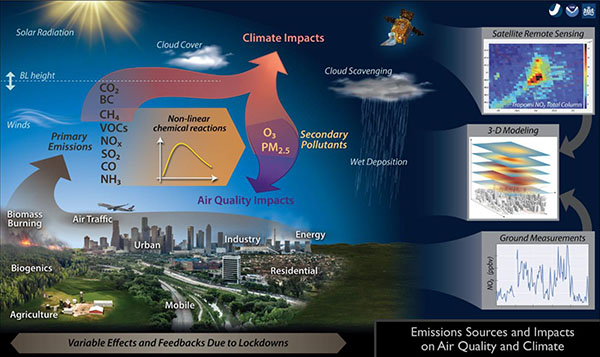A .gov website belongs to an official government organization in the United States.
A lock () or https:// means you've safely connected to the .gov website. Share sensitive information only on official, secure websites.
13 April 2021
adapted from the press release by Forschungszentrum Jülich

A consequence of the coronavirus pandemic has been restrictions on mobility worldwide. This has had an impact on atmospheric pollution. Researchers around the world are using this unique opportunity to take measurements, collect data, and publish studies. An international team led by CSL researchers Georgios Gkatzelis, now at Forschungszentrum Jülich, Jessica Gilman, and Steve Brown has published a comprehensive review providing an overview of results up to September 2020. The study also has its own dedicated website, where additional measurement data can be added to supplement and refine existing research results At the same time, this collection of data allows scientifically substantiated predictions to be made about the pollution levels of future mobility scenarios.
The meta-analysis was coordinated by Prof. Astrid Kiendler-Scharr, Director of the Jülich Institute of Climate and Energy Research - Troposphere. The analysis includes measurement data from around 200 studies from the first seven months of the lockdown. It focuses on the air pollutants nitrogen dioxide, particulate matter, ozone, ammonia, sulphur dioxide, black carbon (soot), volatile organic compounds (VOCs) and carbon monoxide. A third of the studies take into account the prevailing meteorological situation for the calculation of the lockdown influence on air composition. The Government Stringency Index (SI), summarizing the severity of local shutdown measures in a number that can be compared at international level, acted as a reference value.
A key finding of the analysis is that lockdowns, implemented to restrict the spread of infection, also reduce the exposure of the atmosphere to nitrogen dioxide and particulate matter worldwide – the higher the SI, the greater the impact. However, this only applies to pollutants which have a primary anthropogenic origin, i.e. are directly emitted by humans, especially in the field of mobility. In contrast, ozone levels have increased. This increase was a result of atmospheric chemical processes caused by reduced nitrogen oxides in the air.

An important addition to the meta-analysis is the 
The important data could also form the basis for better assessments of the impacts on atmospheric chemistry in future scenarios. This includes a considerable, long-term reduction in pollution levels for a comprehensive transition to electromobility.
Gkatzelis, G.I., J.B. Gilman, S.S. Brown, H. Eskes, A.R. Gomes, A.C. Lange, B. McDonald, J. Peischl, A. Petzold, C. Thompson, and A. Kiendler-Scharr, The global impacts of COVID-19 lockdowns on urban air pollution: A review, Elementa: Science of the Anthropocene, doi:10.1525/elementa.2021.00176, 2021.
The coronavirus-19 (COVID-19) pandemic led to government interventions to limit the spread of the disease which are unprecedented in recent history; for example, stay at home orders led to sudden decreases in atmospheric emissions from the transportation sector. In this review article, the current understanding of the influence of emission reductions on atmospheric pollutant concentrations and air quality is summarized for nitrogen dioxide (NO2), particulate matter (PM2.5), ozone (O3), ammonia, sulfur dioxide, black carbon, volatile organic compounds, and carbon monoxide (CO). In the first 7 months following the onset of the pandemic, more than 200 papers were accepted by peer-reviewed journals utilizing observations from ground-based and satellite instruments. Only about one-third of this literature incorporates a specific method for meteorological correction or normalization for comparing data from the lockdown period with prior reference observations despite the importance of doing so on the interpretation of results. We use the government stringency index (SI) as an indicator for the severity of lockdown measures and show how key air pollutants change as the SI increases. The observed decrease of NO2 with increasing SI is in general agreement with emission inventories that account for the lockdown. Other compounds such as O3, PM2.5, and CO are also broadly covered. Due to the importance of atmospheric chemistry on O3 and PM2.5 concentrations, their responses may not be linear with respect to primary pollutants. At most sites, we found O3 increased, whereas PM2.5 decreased slightly, with increasing SI. Changes of other compounds are found to be understudied. We highlight future research needs for utilizing the emerging data sets as a preview of a future state of the atmosphere in a world with targeted permanent reductions of emissions. Finally, we emphasize the need to account for the effects of meteorology, emission trends, and atmospheric chemistry when determining the lockdown effects on pollutant concentrations.